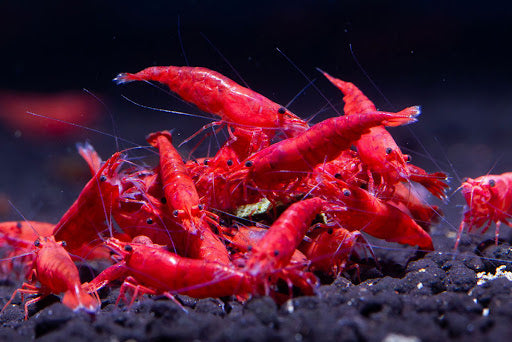Freshwater aquarium shrimp are the most commonly kept type and include popular species such as Cherry Shrimp (Neocaridina davidi), Crystal Red Shrimp (Caridina cantonensis), Amano Shrimp (Caridina multidentata), and Ghost Shrimp (Palaemonetes sp.). These shrimp are typically easy to care for, breed readily in captivity, and contribute to the overall health of the aquarium ecosystem by scavenging for algae and detritus.
Several factors could contribute to shrimp deaths in an aquarium. Here are some common reasons why shrimp might be dying:
-
Water Parameters: Poor water quality is often the leading cause of shrimp deaths. Parameters such as ammonia, nitrite, nitrate, pH, temperature, and hardness should be within suitable ranges for the species of shrimp you are keeping. Sudden changes or fluctuations in water parameters can stress and ultimately harm shrimp.
-
Chlorine and Chloramines: If tap water is used in the aquarium, chlorine and chloramines must be removed or neutralized before adding it to the tank. These chemicals are harmful to shrimp and can cause sudden deaths or long-term health issues if not addressed.
-
Acclimation: Improper acclimation procedures when introducing shrimp to the aquarium can lead to stress and death. Shrimp should be slowly acclimated to the new water parameters to minimize stress and allow them to adjust gradually.
-
Disease: Shrimp are susceptible to various diseases, including bacterial infections, fungal infections, and parasitic infestations. Poor water quality, stress, and overcrowding can weaken shrimp's immune systems, making them more vulnerable to diseases.
-
Predation: Shrimp may become prey to aggressive or predatory tank mates, such as larger fish or crayfish. Providing adequate hiding places and shelters can help protect shrimp from potential predators.
-
Overfeeding: Overfeeding can lead to excess organic waste buildup in the aquarium, resulting in deteriorating water quality and increased ammonia levels. Uneaten food can also rot and produce toxins harmful to shrimp.
-
Incompatible Tank Mates: Some fish species may harass or stress out shrimp, leading to injuries or death. Similarly, certain fish may compete with shrimp for food or territory, causing conflicts and negatively impacting shrimp health.
-
Temperature Fluctuations: Sudden changes in water temperature, either due to equipment malfunctions or environmental factors, can stress shrimp and lead to fatalities. It's essential to maintain stable water temperatures within the appropriate range for the species of shrimp you are keeping.
-
Chemical Contamination: Exposure to chemicals or toxins from cleaning products, medications, or aerosols near the aquarium can be fatal to shrimp. Always be cautious when using any substances near the tank and ensure they are shrimp-safe.
-
Genetic Factors: In some cases, shrimp may suffer from genetic abnormalities or weaknesses that make them more prone to illness or premature death. Selecting healthy and robust shrimp from reputable sources can help minimize the risk of genetic issues.
To address shrimp deaths, it's crucial to assess and address any potential issues with water quality, tank parameters, tank mates, and husbandry practices. Regular water testing, proper maintenance, and attentive observation of shrimp behavior can help identify and mitigate problems before they escalate.

